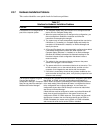
2-12 Troubleshooting
2.3.8 CD-ROM Drive Problems
This section identifies some quick checks for CD-ROM drive problems.
Table 2-8
CD-ROM Drive Problems
Problem Possible Solution
Cannot read compact disc. 1. CD is not properly seated in the drive. Eject the CD, correctly seat
it in the drive, then reload.
2. CD has been loaded upside down. Eject the CD, turn it over, then
reload.
System will not boot from CD-ROM
drive.
1. The CD-ROM boot is not enabled through the CMOS Setup utility.
Run the CMOS Setup utility and set the drive priorities.
2. Ensure that drive cabling and jumpers are set correctly. To boot a
SCSI drive, the drive ID number must be set to 0.
Cannot eject compact disc (tray-
load unit only).
CD is not properly seated in the drive. Turn off the computer and
insert a thin metal rod into the emergency eject hole and push firmly
(a straightened paper clip can be used). Slowly pull the tray out from
the drive until the tray is fully extended, then remove the CD.
CD-ROM device is not detected;
driver is not loaded.
CD-ROM drive is not connected properly. Open the computer and
check to see that the drive cable is connected properly and the drive
jumpers are set correctly.
✎
Some features may not be available on all models.
2.3.9 Memory Problems
This section identifies some quick checks for memory-related problems.
Table 2-9
Memory Problems
Problem Possible Solution
Out of Memory error. 1. In Windows 95, use the Device Manager to check memory
configuration.
2. The computer has run out of memory to run the application. Check
the application documentation to determine the memory
requirements.
Memory count during POST is
wrong.
The memory modules may not be installed correctly. Check that the
memory modules have been installed correctly and that mixed EDO
and FPM DRAM are in the correct bank, then run the Configuration
utility. (If the system contains mixed EDO and FPM DRAMs, the EDO
pair is one bank and the FPM pair is another bank.)
Insufficient memory error during
operation
1. Too many Terminate and Stay Resident programs (TSRs) are
installed. Delete any unnecessary TSRs.
2. The computer has run out of memory for the application. Check
the memory requirements for the application or add more memory
to the computer.


















